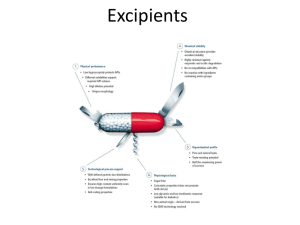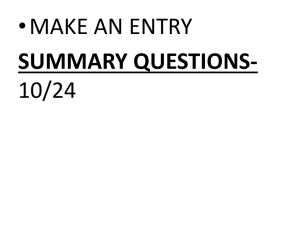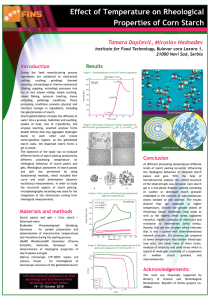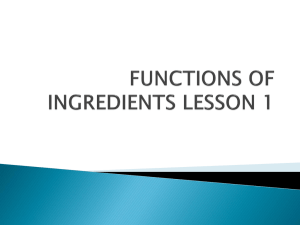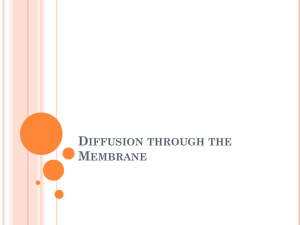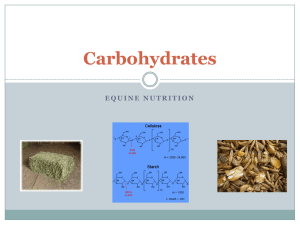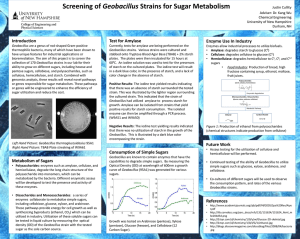Starch, Glycogen, Cellulose: Structure & Function
advertisement
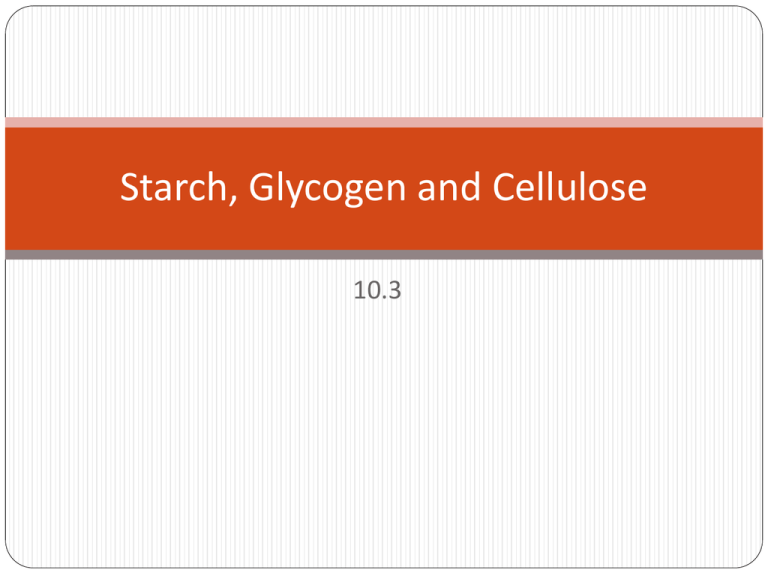
Starch, Glycogen and Cellulose 10.3 Starter Haemoglobin summary on kerboodle Exam Practice Haemoglobin is a protein. A) What is meant by the quaternary structure of a protein? (1 mark) B) The tertiary structure of haemoglobin allows it to carry oxygen. Explain how. (2 marks) 1 (a) the way in which polypeptide chains fit together; 1 Quaternary structure only applies to a protein molecule that has more than one chain, so you must put chains to show more than one. (b) each polypeptide has a specific 3D shape; haemoglobin has hydrophilic groups that allow it to mix with blood; The specific shape allows the oxygen molecules to fit into the proteins. The hydrophilic groups are on the outside of the molecule and can access the oxygen in the blood. 2 Learning Objectives and Success Criteria Describe how α-glucose You can match up monomers are arranged to form the polymers of starch and glycogen Describe how β-glucose monomers are arranged to form the polymer cellulose Explain how the structures of starch, glycogen and cellulose relate to their functions carbohydrates to functions You can make models of the structure of glucose, starch and cellulose You can answer exam questions on carbohydrates Starch Structure Starch is made from chains of α-glucose monomers These are linked by glycosidic bonds, formed by condensation reactions (water released) Draw out an α-glucose monomer Starch Structure The chain of α-glucose is wound into a tight coil Starch Where is starch found in a plant? Many parts as starch grains Seeds Storage organs e.g. Potato tubers Why is starch a good molecule for storage in plants? In pairs come up with a list of reasons It is insoluble, so doesn’t draw water into cells by osmosis Won’t easily diffuse out of cells because it is insoluble It can be stored in a small space because the tight coils make it compact Can be easily hydrolysed to give α-glucose, which can be used in respiration Glycogen Starch is not found in animal cells, glycogen is used instead It is similar to starch, but has shorter chains and is more highly branched Storage molecule for animals, found as small granules in the muscles and the liver Because of the shorter chains it is even more readily hydrolysed than starch Cellulose Made of β-glucose, rather than α-glucose Draw a molecule of β-glucose Cellulose To form glycosidic links, each β-glucose molecule is rotated 180° compared to the one next to it Has straight, unbranched chains that run parallel to one another Hydrogen bonds link the chains Cellulose So many hydrogen bonds help to strengthen cellulose This makes cellulose a good structural material, hence its use in plant cell walls to aid rigidity Cellulose does this by grouping together to form microfibrils fibres Cellulose also prevents cells bursting, so they are turgid when full with water. This helps support stems Carbohydrates For each of these statements, pick the correct carbohydrate from the list opposite 1. 2. 3. 4. 5. 6. 7. 8. Stains deep blue with iodine solution Is known as ‘animal starch’ Found in plants Are polysaccharides Monosaccharide found in starch Has a structural function Can be hydrolysed Easily diffuses in and out of cells Carbohydrates – may be used once, more than once or not at all α-glucose β-glucose Starch Cellulose Glycogen Carbohydrates - Answers 1. 2. 3. 4. 5. 6. 7. 8. Stains deep blue with iodine solution - Starch Is known as ‘animal starch’ - Glycogen Found in plants - α-glucose, β-glucose, starch, cellulose Are polysaccharides - Starch, cellulose, glycogen Monosaccharide found in starch - α-glucose Has a structural function - Cellulose Can be hydrolysed - Starch, cellulose, glycogen Easily diffuses in and out of cells - α-glucose, βglucose Activity – make models of the molecules out of the equipment available Make an α-glucose ring Make a starch molecule Make a β-glucose ring Make a cellulose molecule Exam Questions Work through the exam questions on carbohydrates Learning Objectives and Success Criteria Describe how α-glucose You can match up monomers are arranged to form the polymers of starch and glycogen Describe how β-glucose monomers are arranged to form the polymer cellulose Explain how the structures of starch, glycogen and cellulose relate to their functions carbohydrates to functions You can make models of the structure of glucose, starch and cellulose You can answer exam questions on carbohydrates
